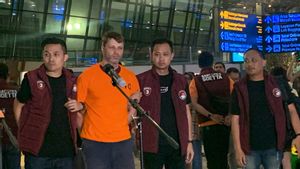JAKARTA - SpaceX's satellite constellation project, Starlink will soon get its first customer. This time, the startup owned by Elon Musk is discussing contracts with a number of airlines to provide in-flight internet services.
Starlink is known to initially only target rural areas, but has now developed into airlines. This move is certainly what Elon Musk as the owner of the company hopes to do, and make it a commercial broadband network later this year.
“We have our own aviation product in development. We've done several demonstrations to date, and want to finalize the product for installation on aircraft in the near future," said SpaceX VP of Starlink and commercial sales Jonathan Hofeller.
Deployment of 60 Starlink satellites confirmed pic.twitter.com/qBtLpzV9ya
— SpaceX (@SpaceX) May 26, 2021
This news is of course not so surprising, because last year, SpaceX proposed a plan to test Starlink on five Gulfstream jets. In March, SpaceX sought FCC approval to use Starlink with what it calls Earth Stations in Motion — industry jargon to refer to any vehicle that will receive a signal, including cars, trucks, ocean liners, and airplanes.
On Friday, Starlink sought FCC approval again for testing in five US states of an updated receiver with a square-shaped antenna, the basic design commonly associated with aircraft antennas.
Hofeller said SpaceX's airline antenna design will be very similar to the technology inside its consumer terminals, but with clear improvements to flight connectivity.
The in-flight hardware will be designed and built by SpaceX itself. The aerial antenna can connect with the Earth station to communicate with the Starlink satellites.
"For Starlink to provide connectivity to aircraft flying over remote parts of the ocean, away from Earth stations, it will require inter-satellite links — the ability where satellites talk to each other using laser links without first reflecting signals from the Earth stations. the next of our constellations, which are working, will have this inter-satellite connectivity,” Hofeller explained.
Since 2018, SpaceX has launched nearly 1,800 Starlink satellites out of the approximately 4,400 needed to provide global broadband internet coverage, especially for residents in rural areas, where internet networks alone are not available.
The company is in the middle of a beta phase of Starlink promising download speeds of up to 100Mbps and upload speeds of 20Mbps, with tens of thousands of users so far.
Most users pay $99 per month for the beta internet service, using a $499 bundle of self-aligning Starlink network and Wi-Fi routers.
However, Starlink still has fierce rivals such as Intelsat and ViaSat, which operate a network of satellites in geostationary orbit. ViaSat recently announced plans to deploy a next-generation satellite network in Delta's flagship fleet.
The California-based company is planning its own low-orbit network of 300 satellites as well as a trio of new geostationaries that will begin launching early next year.
The English, Chinese, Japanese, Arabic, and French versions are automatically generated by the AI. So there may still be inaccuracies in translating, please always see Indonesian as our main language. (system supported by DigitalSiber.id)












